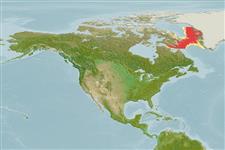Environment: milieu / climate zone / depth range / distribution range
पारिस्थितिकी
समुद्री बाथीड़िमरसल; गहराई सीमा 39 - 1200 m (Ref. 117245), usually 71 - ? m (Ref. 117245). Deep-water; 0°C - 5°C (Ref. 35388); 74°N - 61°N, 72°W - 45°W (Ref. 117245)
Arctic to Northwest Atlantic: Canada to Greenland.
आकार / वज़न / Age
Maturity: Lm ? range ? - ? cm
Max length : 52.0 cm TL पुल्लिंग / अलिंग; (Ref. 4695); common length : 27.5 cm TL पुल्लिंग / अलिंग; (Ref. 4695)
Dorsal fin without depression, front end with 0-3 black - brown spots. Lateral line runs near the anal fin (Ref. 35388).
Lives at temperature of 0-5°C. Off Greenland it measures 50 cm and off Scandinavia rarely over 25-30 cm (Ref. 35388). Benthic (Ref. 58426). Feeds mostly on endobenthic prey, with shrimps and euphausiids becoming the more prominent prey as the size increases (Ref. 13532). Prefers warmer waters (Ref. 13534). Large eggs of 6 mm diameter are deposited on the sea floor.
Life cycle and mating behavior
परिपक्व अवधि | पुनरुत्पत्ति | मछलीऔ का अंडे देना | अंडे | Fecundity | लार्वा
Anderson, M.E., 1994. Systematics and osteology of the Zoarcidae (Teleostei: Perciformes). Ichthyol. Bull. J.L.B. Smith Inst. Ichthyol. 60:120 p. (Ref. 11954)
IUCN Red List Status (Ref. 130435)
Threat to humans
Harmless
Human uses
मात्स्यिकी: निर्वाह मात्स्यिकी
अधिक जानकारी
आम नामउपशब्दचपायचयपरभक्षीईकोटोकसीकोलौजीपुनरुत्पत्तिपरिपक्व अवधिमछलीऔ का अंडे देनाSpawning aggregationFecundityअंडेEgg development
संदर्भजलीयकृषिजलीयकृषि रूपरेखाखींचआनुवंशिकीElectrophoresesहैरेटिबिलटीबीमारीप्रक्रमणNutrientsMass conversion
सहयोगीयोतस्वीरेStamps, Coins Misc.ध्वनिसिगुयटिरारफ्तारतैरने के प्रकारगिल क्षेत्रOtolithsदिमागदृष्टि
साधन
Special reports
Download XML
इंटरनेट स्रोत
Estimates based on models
Preferred temperature (Ref.
123201): 1.4 - 5.6, mean 3.2 °C (based on 263 cells).
Phylogenetic diversity index (Ref.
82804): PD
50 = 0.5000 [Uniqueness, from 0.5 = low to 2.0 = high].
Bayesian length-weight: a=0.00219 (0.00137 - 0.00348), b=3.18 (3.04 - 3.32), in cm total length, based on LWR estimates for this species & (Sub)family-body (Ref.
93245).
Trophic level (Ref.
69278): 3.4 ±0.42 se; based on food items.
लौटाव (Ref.
120179): बहुत नीचे, न्यूनतम जनसंख्या दुगनी समय अवलागत 14 महीने। (Preliminary K or Fecundity.).
Fishing Vulnerability (Ref.
59153): Moderate vulnerability (41 of 100).
